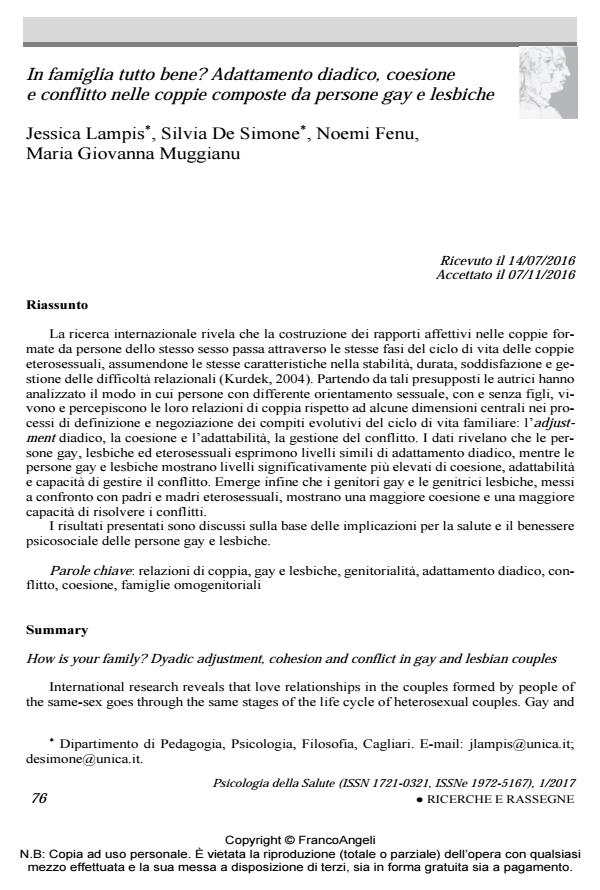In famiglia tutto bene? Adattamento diadico, coesione e conflitto nelle coppie composte da persone gay e lesbiche
Titolo Rivista PSICOLOGIA DELLA SALUTE
Autori/Curatori Jessica Lampis, Silvia De Simone, Noemi Fenu, Maria Giovanna Muggianu
Anno di pubblicazione 2017 Fascicolo 2017/1
Lingua Italiano Numero pagine 21 P. 76-96 Dimensione file 366 KB
DOI 10.3280/PDS2017-001004
Il DOI è il codice a barre della proprietà intellettuale: per saperne di più
clicca qui
Qui sotto puoi vedere in anteprima la prima pagina di questo articolo.
Se questo articolo ti interessa, lo puoi acquistare (e scaricare in formato pdf) seguendo le facili indicazioni per acquistare il download credit. Acquista Download Credits per scaricare questo Articolo in formato PDF

FrancoAngeli è membro della Publishers International Linking Association, Inc (PILA)associazione indipendente e non profit per facilitare (attraverso i servizi tecnologici implementati da CrossRef.org) l’accesso degli studiosi ai contenuti digitali nelle pubblicazioni professionali e scientifiche
La ricerca internazionale rivela che la costruzione dei rapporti affettivi nelle coppie formate da persone dello stesso sesso passa attraverso le stesse fasi del ciclo di vita delle coppie eterosessuali, assumendone le stesse caratteristiche nella stabilità, durata, soddisfazione e gestione delle difficoltà relazionali (Kurdek, 2004). Partendo da tali presupposti le autrici hanno analizzato il modo in cui persone con differente orientamento sessuale, con e senza figli, vivono e percepiscono le loro relazioni di coppia rispetto ad alcune dimensioni centrali nei processi di definizione e negoziazione dei compiti evolutivi del ciclo di vita familiare: l’adjustment diadico, la coesione e l’adattabilità, la gestione del conflitto. I dati rivelano che le persone gay, lesbiche ed eterosessuali esprimono livelli simili di adattamento diadico, mentre le persone gay e lesbiche mostrano livelli significativamente più elevati di coesione, adattabilità e capacità di gestire il conflitto. Emerge infine che i genitori gay e le genitrici lesbiche, messi a confronto con padri e madri eterosessuali, mostrano una maggiore coesione e una maggiore capacità di risolvere i conflitti. I risultati presentati sono discussi sulla base delle implicazioni per la salute e il benessere psicosociale delle persone gay e lesbiche.
Parole chiave:Relazioni di coppia, gay e lesbiche, genitorialità, adattamento diadico, conflitto, coesione, famiglie omogenitoriali
- Lesbian and gay individual parenting desires in heteronormative contexts Diego Lasio, Jessica Lampis, Roberta Spiga, Francesco Serri, in Europe’s Journal of Psychology /2020 pp.210
DOI: 10.5964/ejop.v16i2.1808 - Relationship Satisfaction, Social Support, and Psychological Well-Being in a Sample of Italian Lesbian and Gay Individuals Jessica Lampis, Silvia De Simone, Christopher K. Belous, in Journal of GLBT Family Studies /2021 pp.49
DOI: 10.1080/1550428X.2020.1724844 - Italian primary school teachers’ comfort and training needs regarding same-sex parenting Silvia De Simone, Francesco Serri, Jessica Lampis, Jessica Pileri, Diego Lasio, in Psychology & Sexuality /2022 pp.404
DOI: 10.1080/19419899.2020.1820557
Jessica Lampis, Silvia De Simone, Noemi Fenu, Maria Giovanna Muggianu, In famiglia tutto bene? Adattamento diadico, coesione e conflitto nelle coppie composte da persone gay e lesbiche in "PSICOLOGIA DELLA SALUTE" 1/2017, pp 76-96, DOI: 10.3280/PDS2017-001004